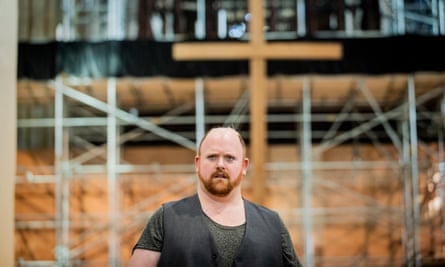When six marimbas whir quietly to life at the start of A Man of Good Hope, it’s as if a breeze is uncurling on the horizon. Everyone should see – and hear – the Isango Ensemble at least once in their lives. This was my second encounter with the South African company, even better than the first, three years ago. Throughout this musical theatre piece, those xylophone-like instruments, identifiable by wooden rather than metal bars, run the gamut of expression, musical and emotional. With a full chromatic capacity, and ranging from soprano to bass, they create their own world of sound. The story of A Man of Good Hope is compelling. The music is its lifeblood.
Founded by Mark Dornford-May and Pauline Malefane in 2000 and based in Cape Town, Isengo consists of singers and actors of all ages drawn from the city’s townships, some classically trained, others not. They each play, sing, dance, speak with fluidity and invention, and have travelled the world with productions of A Christmas Carol (Ikrismas Kherol), and The Magic Flute (Impempe Yomlingo) produced by David Lan, former artistic director of the Young Vic, with whom the group has had a longstanding collaboration. They’ve won awards, performed in London’s West End, and have an international reputation. It hasn’t weakened or diluted their singular collective talent.
A Man of Good Hope, first seen at the Young Vic in 2016 and now at the ROH Linbury, is a co-production with the Royal Opera House and companies in New York and Luxembourg – a random assemblage, prepared to risk giving support to Isango in their first attempt at telling one of their own stories rather than adapting a work from the western canon. Taken from the book of the same name by Jonny Steinberg, it’s the true account of a young Somali refugee’s journey through Africa. Asad Abdullahi, at the age of eight, sees his mother murdered in front of him. It’s the start of years of wandering, rejection, indomitable hope.
The factual backstory is fascinating, but the work stands powerfully alone: a sequence of scenes and stories, often violent, tackling issues of racial, cultural, political identity, threaded together by the music of Mandisi Dyantyis. Folding endlessly from solo to choral to instrumental, the score consists both of newly composed music and found songs or rhythms from the various countries Asad travels through. Dyantyis is co-credited, with Pauline Malefane, as music director. Dornford-May directs.
Props and staging are minimal – door frames to suggest a journey, a boundary, a barrier; a few boxes; little else. The company itself creates variety, shape, definition, energy. The gifted Siphosethu Hintsho, in his mid-teens and with an unforgettable capacity for onstage joy, gives a mesmerising performance as the boy Asad. He’s grown up in the role. Go while you can. The company is also performing its new show, SS Mendi: Dancing the Death Drill – too late for this week’s column but also running until 4 May.

Faust may have been based on the poem of a German, Goethe, but in Gounod’s hands it has the feel of a French second empire extravaganza – especially in David McVicar’s 2004 production, designed by Charles Edwards, now back at the Royal Opera House in its fifth revival, conducted by Dan Ettinger. Faust and Méphistophélès explore the fleshpots of Montmartre’s Cabaret de l’Enfer in this most detailed and Parisian of stagings. It’s a little ragged at the edges but still oddly magnificent in its mix of vulgarity, desire and religiosity. Gounod was born in the Latin Quarter of Paris, minutes from Notre Dame, a point not lost at Monday’s performance, news feeds flashing up headlines of the cathedral in flames even as we took our seats.
While opening night had a last-minute stand-in (Mandy Fredrich, replacing Irina Lungu, replacing Diana Damrau, and so it goes), by this second performance Russian soprano Lungu had recovered. After a slightly dry start she warmed to her task and matched the vocal heights of her scurrilous menfolk, American tenor Michael Fabiano as a smooth, narcissistic Faust, and Uruguayan bass-baritone Erwin Schrott as his sneering, sardonic master, Méphistophélès. In five acts complete with ballet (choreography, refreshingly sharp and narky, by Michael Keegan-Dolan), Faust trundles along ponderously then grabs you with its melodic set-piece arias and big ensembles: Valentin’s Avant de quitter ces lieux (a fervent, properly stolid Stéphane Degout), the Soldiers’ Chorus. There’s no point resisting.
Prayers were offered to Paris before Wednesday’s Ryedale festival performance of the Prelude to Act 1 and Act 3 of Parsifal in York Minster. The building, as no one needed reminding, has its own history of devastation by fire, and renewal. Parsifal’s theme is suffering and redemption, its third act set on Good Friday (though Wagner denied specifically Christian associations and the “theology” is certainly droll). Mark Elder, our leading Wagnerian, conducted the Hallé orchestra and choir, with singers from the Royal Northern College of Music and the University of York, drawing a massive, slow-reverberating sound from his performers. Music and silence, gothic architecture and Wagnerian grand structure, met as one.
Molly Barker’s Kundry, Gábor Bretz’s tireless but world-weary Gurnemanz and Michael Kraus, luxury casting as an urgent, railing Amfortas, made a sturdy lineup of soloists, completed by Nicky Spence singing the title role for the first time. This is an exciting boost for this Scottish tenor, and for us in prospect. He already inhabits the part: singing radiantly, with a stillness and nobility absolutely right for Wagner’s “holy fool”. The soaring transept under which he stood stole some of his vocal bloom, but think how he will sound in a theatre. We have a new Parsifal.

Star ratings (out of five)
A Man of Good Hope ★★★★
Faust ★★★★
Parsifal ★★★★
A Man of Good Hope is at the Linbury theatre, Royal Opera House, London, until 4 May

Comments (…)
Sign in or create your Guardian account to join the discussion